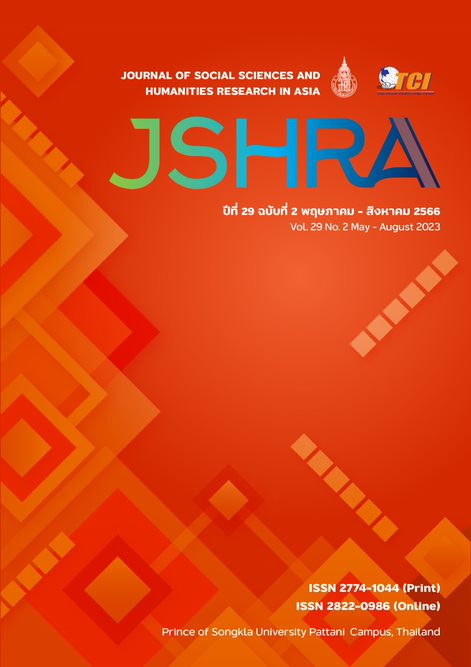Error Analysis of Using Chinese Noun Classifier with Noun: A Case Study of Chinese Language Program Students in the Faculty of Humanities and Social Sciences at Suratthani Rajabhat University
Keywords:
ข้อผิดพลาด, คำลักษณนามจีน, ภาษาจีน, มหาวิทยาลัยราชภัฏสุราษฎร์ธานีAbstract
The objectives of this thesis were 1) to analyze the errors of using Chinese classifiers and nouns; 2) to identify the cause and the solution guideline of the errors. The sample consisted of Chinese Language Program year 2 students of Suratthani Rajabhat University, and qualitative and survey methods were used by gathering information from Chinese language proficiency textbooks on the topics of conjunctions and classifers. The study's findings are as follows: 1) 22 Chinese Language Program year 2 students of Suratthani Rajabhat University had most common human-related Chinese classifier errors, accounted for 11.21%, followed by animal- related Chinese classifier errors at 9.70%, and, lastly, plant-related Chinese classifier errors at 2.12 2) From the data analysis based on the linguistic framework of the Chinese classifier and the concept of error analysis, it was found that the errors in the use of Chinese classifers with nouns were not only the students' one-sided positive transfer influenced by their native language but was also relevant to their thinking systems, attitudes towards the world, and the differences between Thai-Chinese culture. Additionally, the research concludes with recommendations for teaching the origins of Chinese alphabets, helping students understand more on vocabulary in their lessons.
References
Aiemworamet, T. (2010). Chinese –Thai dictionary. Bangkok: Ruamsarn Press.
Apaipong, A. (2020). The error analysis noun classifiers in Mandarin related Chinese sentence structure of Thai students and teaching advice. Panyapiwat Journal, 12(1), 315-324.
Bian, W.H. (2011). New edition explanation Chinese characters. Beijing: The Chinese Overseas Publishing House Press.
Chanturat, K. (2018). Applied linguistics in language Learning. Bangkok: Ramkhamhaeng University Press.
Chen, M.X. (2016). A Contrastive study of appearance classifiers in Chinese and Thai from the perspective of cognitive – Chinese error analysis of Thai learner (Doctoral Dissertation). Shandong University.
Fan, X.Y. (2009). A comparative study on classifiers of Chinese and Thai (Doctoral Dissertation). Beijing Language and Culture University.
Kittiwong, W. (2018). Complete version 3rd update for preparing for the assistant teacher examination. Nonthaburi: Think Beyond Press.
Liu, X. (2009). An introduction to teaching Chinese as a second language. Beijing: Beijing Language and Culture University Press.
Lu, Q.H. (2009). The level of Chinese is improving step by step: Conjunction words, classifiers. Suzhou: Suzhou University Press.
Ma, A.M. (2015). The creation and development of classifiers of Chinese. Beijing: China Social Sciences Press.
Mekthawornwathana, T. (2010). The relationship of language, cognition, and culture. Journal of Liberal Arts, Prince of Songkla University, 2(2), 153-159.
Wattanaphanait. (1995). Dictionary of student. Bangkok: Wattanaphanit Printing Press.
Zhang, C. (2009). Comparison of the meaning system of Chinese and Thai measure words and teaching of Chinese measure words in the background of typology. Journal of Chinese teaching in the world, 23(4), 508-518.
Zang, Q. (2012). Picture dictionary of Chinese measure words. Beijing: International Chinese Teaching Research Center, the Commercial Press.











